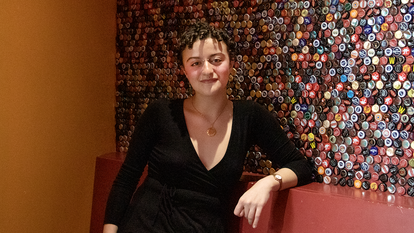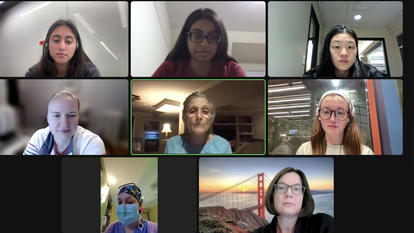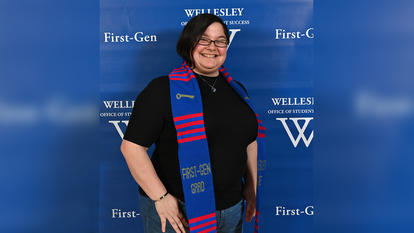
Meet the Student Founders of the Wellesley Data Collective Investigating the Campus Electorate
On March 12, Wellesley held its annual College Government elections. In the weeks leading up to the vote, Shreya Parjan ’21 and Bella Virgilio ’20, founders of the Wellesley Data Collective, were hard at work researching the campus electorate as part of their independent study under the guidance of Eni Mustafaraj, assistant professor of computer science. Taking inspiration from Harvard’s Open Data Project, which sought to predict the result of the university’s College Government elections, they examined Wellesley candidates’ statements of intent, as well as student sentiment about the issues they hoped to see addressed by the 2020–21 cabinet. (They recently wrote about their research for the Wellesley News.) Below, Parjan and Virgilio discuss their work and some of their findings.
What drew you to data science, and will you continue study it after you graduate?
Shreya Parjan ’21: I grew up between California’s Silicon Valley and Central Valley, two interconnected but very different ecosystems. Between the two, through projects on local housing and education data, I learned that effective community problem solving requires understanding communities in their contexts. Working with data is a critical step in doing so. Data science can contextualize and unite individual voices. It challenges us to demand evidence and just representation from the systems, both social and scientific, that we exist in. Next year, I’d like to apply takeaways from a seminar on AI and education I’m taking at MIT to a senior thesis project on data as a vehicle to make thinking about community-centered issues accessible to students from all backgrounds.
Bella Virgilio ’20: My internship last summer at the New York Times really sparked my interest in data science. Up until then I had always been a little intimidated by data, and through my internship I had the opportunity to work on a project that involved collecting and analyzing a large number of tweets for an article on the shortcomings of NJ Transit. I learned that storytelling and data are inextricably linked, and incorporating data science into storytelling can subvert traditional narrative structures in a really interesting and impactful way. I’m hoping to do similar work when I graduate, and as someone who loves storytelling and data, I think that data journalism would be a really fulfilling path to pursue.
Who are some of your favorite data scientists and data journalists?
SP: I really admire the work that Joy Buolamwini from the MIT Media Lab has done at the intersection of art, data, and policy as a champion for algorithmic justice. Buolamwini advocates for thinking critically about how we engage with data and artificial intelligence to prevent algorithmic discrimination and make data-driven technologies that work for everyone. We’re in a hyperquantified era with applications of data to every aspect of our lives, but human life is more than a use case. Before any application, it’s more important to think about how data is collected and who is and isn’t represented.
BV: Some data journalists I look up to include Nate Silver, founder of FiveThirtyEight, and Catherine D’Ignazio and Lauren F. Klein, authors of Data Feminism. Shreya and I both read Data Feminism this past fall in Professor Eni Mustafaraj’s computer science course Data, Analytics, and Visualization. D’Ignazio and Klein present data science as an extremely powerful tool––it can be used to expose inequality and injustice, but it can also be used to reinforce discrimination and surveillance. I am very grateful that their book was my first formal introduction to data science, because I feel like I have a very strong understanding of the importance of intersectionality and ethics in data science.
How did you get involved in this project?
SP: After a semester of thinking about Wellesley through diverse forms of data sourced from students, the archives, and faculty and administration in CS 234, I followed up with Eni about broader ways to engage campus in data-driven conversations about our community. Luckily, she connected me to Bella, whose extensive involvement on campus and passion for data visualization have helped us work toward this goal.
BV: Shreya and I approached Eni independently in the fall about an independent study in data journalism. Eni suggested that we work together, and I was very excited to work with Shreya––her math and computer science background and my media arts and sciences background complement each other really well in this type of work.
Did you have a sense of what data you wanted to focus on, or did that evolve over time?
SP: At first, I wasn’t sure about what kind of data we’d end up having access to or what support would exist for such a project, but Eni did a lot to help us get going through initial conversations with the Office of Institutional Research. Having faculty support has been invaluable in starting this project.
BV: We had some ideas of the data we wanted to work with going into the semester, including College Government elections data, housing data, social media data, and data from the Wellesley News’ police blotters.
Did anything about the process or the data surprise you?
SP: I think both our polling and statement of intent analyses reveal that the College Government cabinet has many constitutional responsibilities that differ from students’ immediate priorities on campus. Our sample suggests that students are seeking action on broader campus issues beyond the immediate duties of College Government cabinet members. This means that elections are critical because cabinet members are not only expected to fulfill their constitutional roles but to act as liaisons between students and administration. As a result, I think it’s important for candidates to campaign on platforms to create actionable dialogue between College Government and admin while encouraging students to participate in the political process.
BV: One aspect of the data that surprised me was students’ responses about whether they were planning to vote. This year Wellesley is transitioning its College Government elections voting to WEngage, the new student events platform. Unfamiliarity with this new system could negatively affect turnout, and I think we saw some early signs of this in the high number of people who responded “No” or “Maybe” to the question “Will you vote in the College Government elections on March 12?” It’ll be interesting to see whether this impact is substantial, or whether the community discussion surrounding this year’s elections will generate higher turnout.
What are you hopeful about for this coming year of College Government?
SP: This year’s election cycle and our own data-driven approach to analyzing it has reinforced how much students value transparency. I know that attending Senate or House Council to receive updates on College Government isn’t an option for all students, so I’d like to see more accessible, disaggregated College Government discourse like what we have closer to elections throughout the year.
BV: I’m hopeful that this coming year’s College Government cabinet and committees can work to address some of the issues that students indicated were most important to them in our poll, like mental health services and institutional support for students of color and low-income students. Members of College Government have always worked hard to represent the interests of their constituents, and I think each year brings important new perspectives on these issues to the College Government space.
Photo (L to R): Shreya Parjan ’21 and Bella Virgilio ’20



